When we talk about hydration, we are referring to the amount of water in the dough.
Increasing hydration is adding more water to the dough recipe.
Decreasing hydration is reducing the amount of water in the dough recipe.
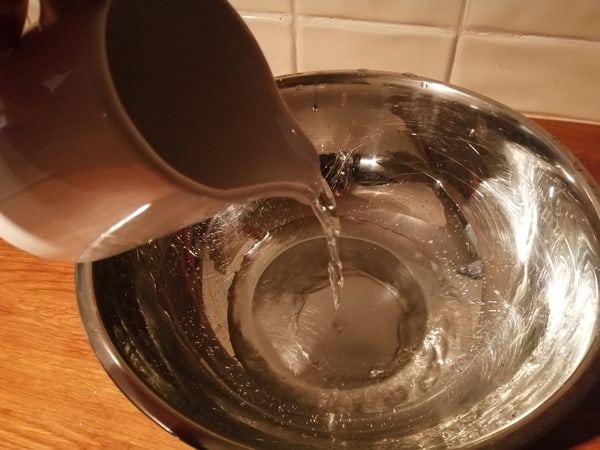
Hydration is expressed as the baker’s percentage. This may sound confusing but it isn’t too bad really.
If you haven’t yet learnt about the baker’s percentage, click here to learn everything you need to know about the baker’s percentage. Once you understand the concept, making dough of any kind becomes a whole lot easier.
If you don’t care to learn about baker’s percentage then don’t worry. There will still be plenty you can learn in this article. You do not need to understand it to learn how to adjust hydration and make great pizzas.
If you think about a really dry dough with very little water in it, it is like a brick. Dry dough is strong but not at all stretchy. Also, once baked, it would be very dense and well, not pleasant to eat.
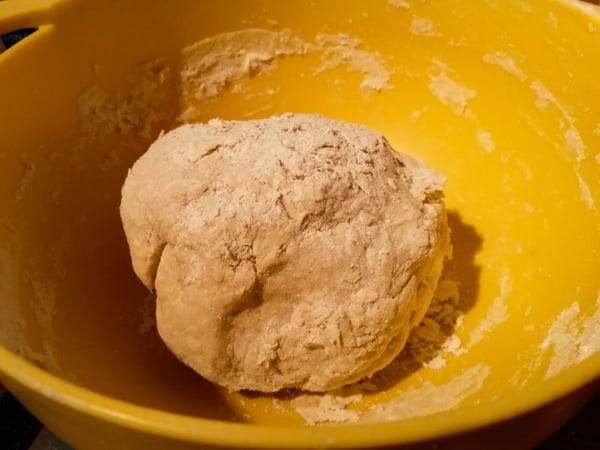
On the other hand, a very wet dough with not much flour is like slime. Wet dough has almost no strength whatsoever but it is very stretchy. When baked, the dough would be much lighter but it would not be able to hold a shape.

These extremes illustrate the importance of proper hydration. For pizza, we need a dough that is:
Achieving all these qualities is a bit of a balancing act. When reducing hydration you will always lose a little stretchiness and when increasing hydration you will always lose a little strength.
The ideal hydration will depend on many factors, including the flour that you are using. In general, 55% – 60% hydration is considered ideal for Neapolitan pizza dough.
“Pizza as we know it today (dough topped with tomatoes and cheese) was invented in Naples. Before the 1700s, flatbreads existed but were never topped with tomatoes, which is now a defining characteristic of pizza.” – Source
Naples is the place for pizza. They have spent centuries perfecting the perfect the perfect pizza recipe.
Think about a traditional Italian pizza cooked in a wood fired oven with a puffy, slightly charred crust. That’s a Neapolitan pizza.
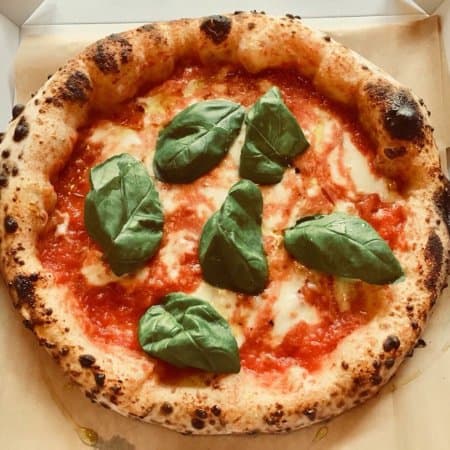
For the ultimate Neapolitan pizza, check out my authentic Neapolitan pizza recipe here.
It is difficult to imitate this style of pizza in a home oven, which is why I recommend getting an affordable pizza oven. However, amazing pizzas are still possible with a domestic oven, you may just need to tweak your methods as you go. All pizza making is about experimentation and trial and error.
To find out more about making pizza in your normal home oven, click here.
Traditionally, Neapolitan pizzas are made in huge wood fired ovens made of brick, like the one below.
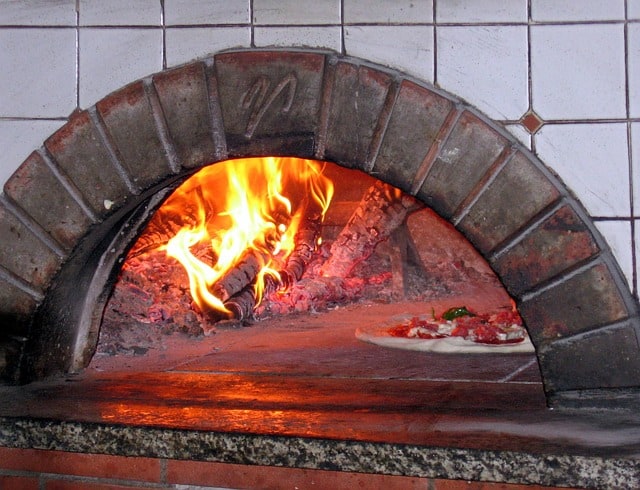
To find out more about this, check out my article on wood fired ovens and wood fired pizza.
Fortunately, these days there lots of affordable portable pizza ovens on the market. The Ooni range for example, can get up to the same temperature as a traditional oven, enabling authentic Neapolitan pizza making at home!
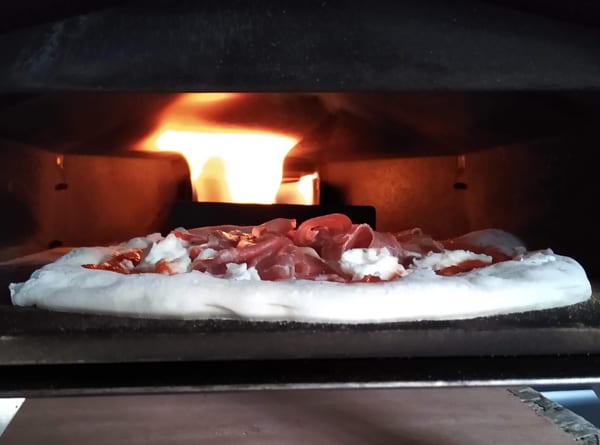
You will need to get to know your own dough in order to find the best hydration for you. I would recommend starting at lower hydrations as drier doughs will be easier to work with.
The biggest factor that will affect your ideal hydration is the flour you are using.
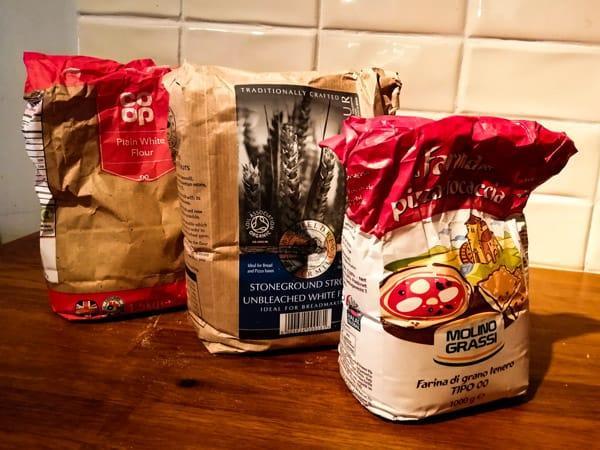
There are many different types of flour widely available and there is great variation between them. Even within the same type of flour, there will be variation between brands.
The recommended flour for Neapolitan pizza is 00 flour (Tipo 00 or Doppio 0 in Italian). This is a very fine, strong flour that is perfect for pizza and pasta.
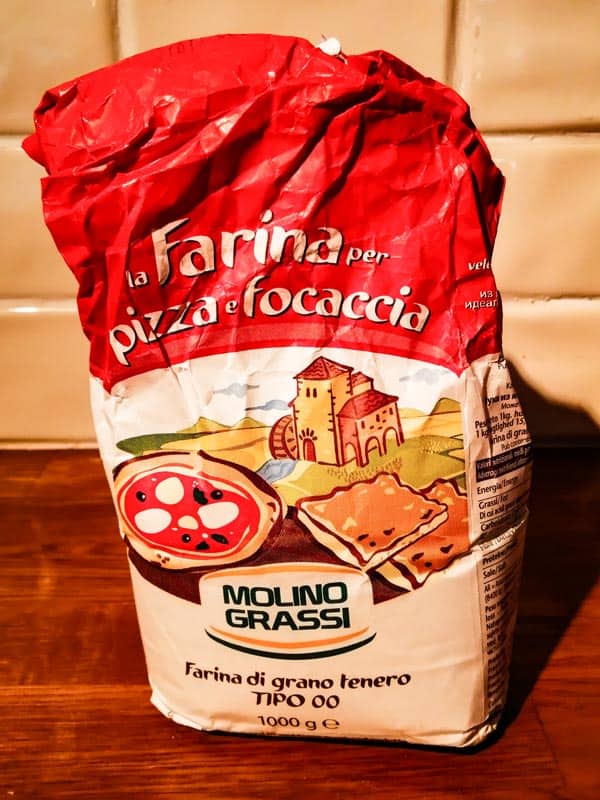
The fineness of the flour produces a softer, more puffy crust. The strength helps us to be able to stretch the pizza out very thinly.
When we talk about the strength of a flour, we are talking about the amount of protein in the flour. Flour consists of two different types of protein; glutenin and gliadin.
When the flour is mixed with water in a dough, these two proteins combine to form gluten. This gives the dough it’s strength, allowing it hold shape effectively.
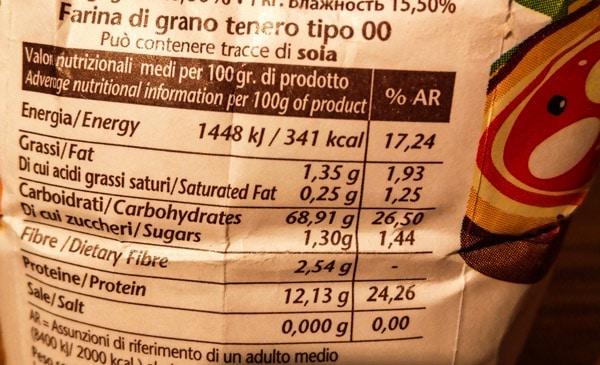
00 flour typically has a protein content of around 12% (12g per 100g), which is quite high. By contrast, most all purpose flour is less than 10% protein. Some bread flours can be as high as 14%. These may not sound like large differences but they make a huge difference to the dough.
12% protein vs 10% protein may seem like only a 2% increase but it isn’t (the 2% is compared to the total weight of ingredients). 12% is actually a 20% increase from 10%. In other words, 00 flour actually contains over 20% more protein than all purpose flour.
00 flour is the best flour for pizzas but it’s not a necessity. It is readily available at most supermarkets these days but if you can’t get hold of it, use strong white bread flour. Failing that, plain flour will still work.
If using strong bread flour, you will probably need to push the hydration a little higher. With strong bread flour I would start at 60% and maybe go up to 62% if required.
I would definitely recommend 00 flour though if you’re serious about making the best homemade pizzas. You can’t make a true Neapolitan pizza without 00 flour, and that’s a fact! You can even get it on Amazon now so there’s no excuses!
If you are new to making pizza dough, check out my recipe for no knead pizza dough using strong white bread flour, it’s super easy!
For the perfect pizza recipe, be sure to check out my authentic Neapolitan pizza recipe here.
The other main factors are your kneading technique and the length of fermentation (proving time).
In general, if you have a more efficient kneading technique, you can increase your hydration. This is because the dough will become stronger and stretchier.
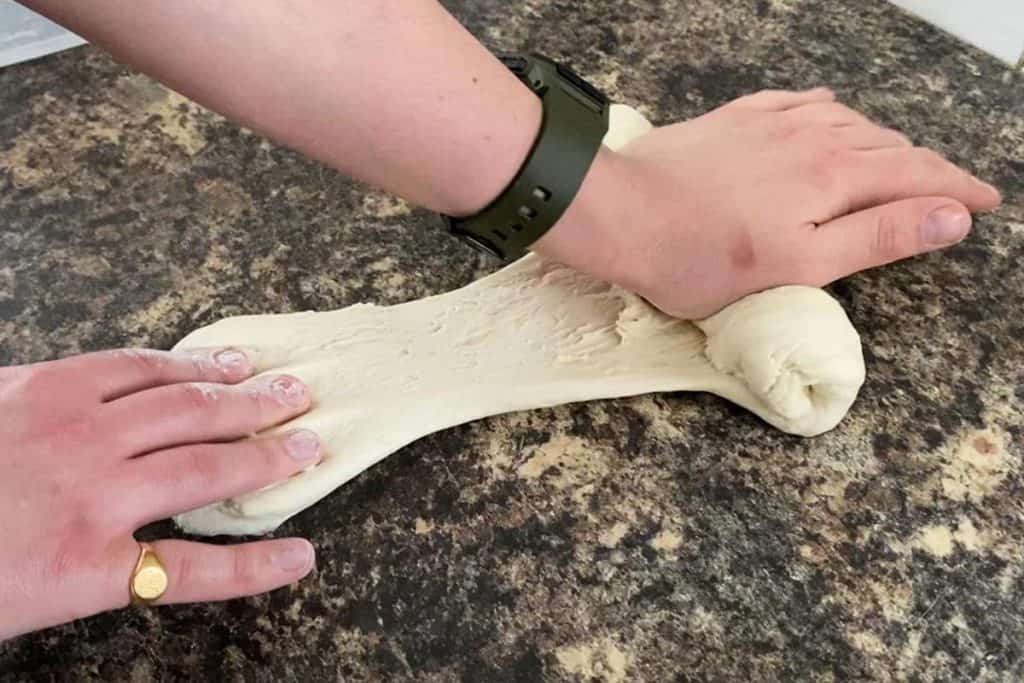
There is no right or wrong way to knead dough, and great pizza can even be achieved with no-knead dough. However, over time you can easily develop you own kneading technique which works for you.
I’ve made an article with a video showing my kneading technique here. This shows the method that works for me, and you may find it works for you also!
The other main thing that affects the hydration is the length of fermentation, or proving. Allowing a dough to ferment for a long time will not only improve flavour, it will also increase strength and improve texture by improving the hydration of the dough.
When using long prove times however, I would recommend reducing the amount of water slightly (1-2%) in your recipe to allow for the increased hydration that will occur naturally.
Increasing the hydration can have a positive affect on the quality of a dough.
Many of the best bread loaves, such as baguettes and ciabattas, are made with very high hydration doughs. Ciabattas can even go into the 80% – 90% hydration range!
This high hydration produces a wonderfully light and airy texture.
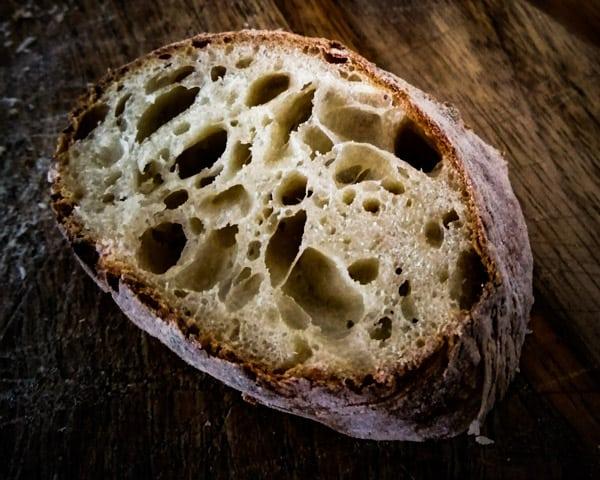
Because pizza is stretched out so thin, it has to have a great deal of strength. This means the hydration has to be much lower.
However, because pizzas are baked at a higher temperature, an airy crust can be achieved with a lower hydration. The increased heat produces greater oven spring. Oven spring is essentially the amount the dough rises when baking.
This is not to say that higher hydration pizza doughs cannot work well. Pushing for a higher hydration is something that you can experiment with as you get more confident.
With higher hydration, more air pockets form and this leads to quicker and greater expansion of the dough when cooking. The leads to a crisper pizza that has a softer, lighter crust.
However, if pushed too far, high hydration can produce a weak dough that is difficult to stretch. This leads to the dough ripping when stretching, or a pizza base that is thick.
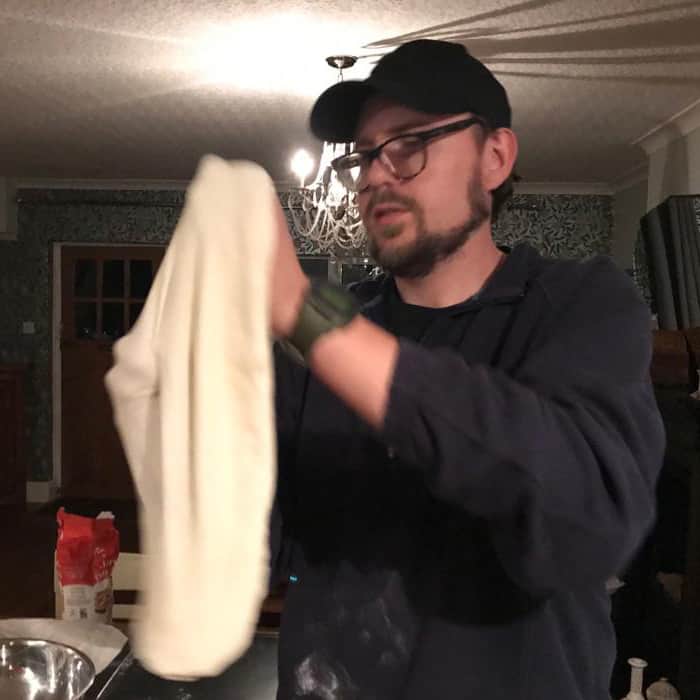
A thick pizza base is not necessarily a bad thing but it can lead to an undercooked dough. It will also be harder to achieve a good level of crispness. In short, it will not produce authentic Italian pizzas.
If you are struggling with an undercooked or soggy pizza, click here to find out more about how to avoid a soggy pizza.
This is why, with 00 flour I would recommend starting at 55% hydration and gradually working up to 60% as you become more comfortable with the dough.
I always mix my dough by hand, it’s a great way to be able to tell if you’ve got the correct hydration. You will be able to feel the dough change as you mix it.
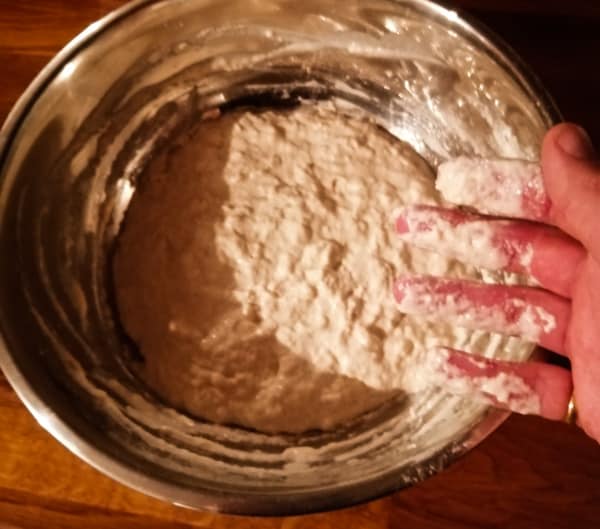
Contrary to popular belief, you do not need a kitchen mixer to make great pizza dough. It’s also not difficult to do it by hand, it’s easy! It’s also really rewarding.
In fact, to be true Neapolitan the dough should be mixed by hand or very slowly by a machine.
If you really can’t stand the thought of getting your hands messy then feel free to use a kitchen mixer. But stop the machine regularly to check your dough. I would not recommend using a bread maker, I have rarely seen good results with one of these.

When mixing your dough initially, it should take a little bit of work to incorporate all the flour. If the flour mixes in really easily, you’ve probably added too much water.
The dough will become softer and stretchier on its own over time. So don’t worry if your dough feels a bit hard and dry to begin with.
On the other hand, if the dough is so tough and dry that it’s hard to knead, you’ve probably not added enough water.
The start of the mixing process is the best time to change the hydration. If it’s not right now, simply add more water or flour until your dough feels about right.
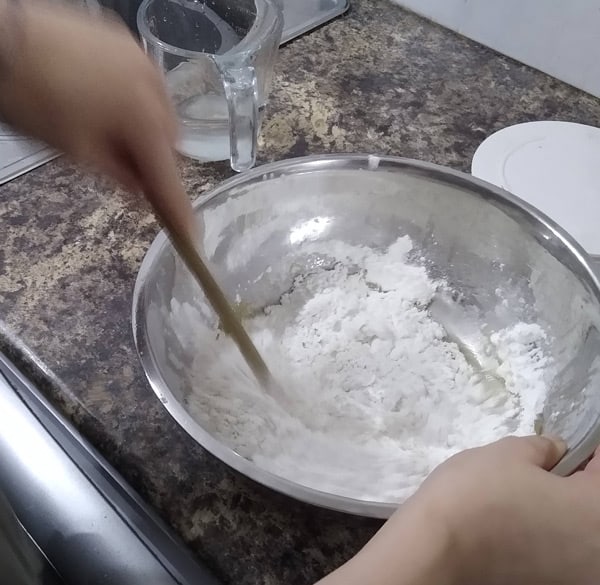
Make a mental note (or real note) of how you adjusted the recipe for next time. But remember, the flour you used will have made a difference to the hydration.
If your hydration is too low, your dough will be difficult to stretch out. Also, the crust will be quite dense.
If this is the case with your pizzas, that’s a sure fire sign that you need to increase the hydration. Simply increase the amount of water in your recipe by 2% – 3% bakers percentage. Remember to stay inside the 55% – 60% for Neapolitan pizza.
If you find that your dough stretches out really easily but also tears easily, then your hydration is likely too high. Try lowering the amount of water by 2% – 3% baker’s percentage.
This should help to produce a dough that is stronger but still stretchy. Don’t stray outside the 55% – 60% for the true Neapolitan pizza dough.
Achieving the correct hydration for authentic Italian Neapolitan pizza dough is something that takes a bit of experience. But hopefully you’ve now got a better understanding of how hydration affects pizza dough.
Getting the right hydration will take your pizza game to the next level. You will be able to make strong and stretchy dough that will be fun and easy to shape.

That crispy, yet soft and tender pizza is not far away. So get mixing, and let’s some amazing pizza!
To get starting on your dough, check out my easy no-knead dough here or my authentic Neapolitan pizza recipe here.

I’m Tom Rothwell and I’m super passionate about all kinds of homemade pizza! In the last few years I've been on a quest to find the perfect pizza. Now I'm sharing what I've found out with the world!

If you're interested in hiring me for your event in the UK, feel free to check out my website with the link below.
Pizza Catering
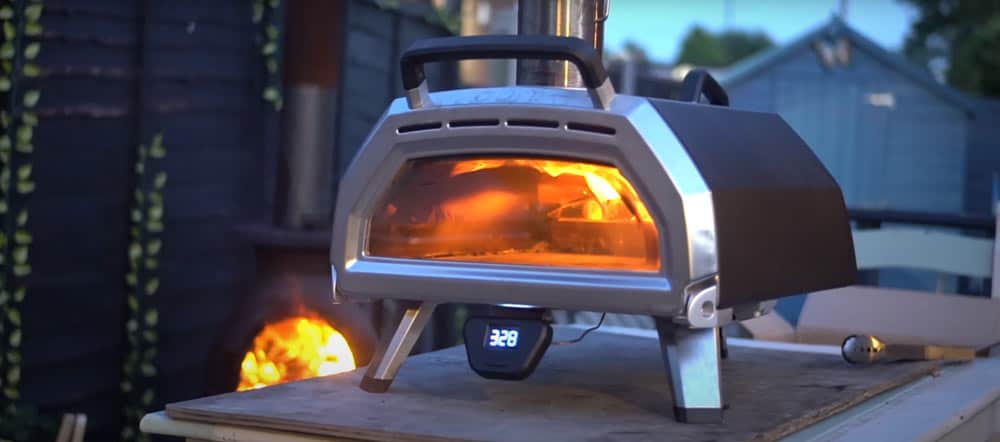
I often get asked what type of oven I use for my pizzas. Well, I use a pizza oven made by a company called Ooni.
The range of pizza ovens that Ooni offers is just brilliant. They cover all bases, and all price points. There's affordable and portable models such as the Fyra 12 Pizza Oven and then there's state-of-the-art models such as the Karu 16 Pizza Oven pictured below.
In all honesty, I would say that the oven makes a huge difference. If you're looking to make authentic Italian pizza, a pizza oven is a must.
By clicking the link below and purchasing from Ooni, you would be supporting this website. I've been using their ovens for a long time now and I wouldn't recommend them if I didn't believe in their products.
Time to make some amazing pizza!

I’m Tom Rothwell and I’m super passionate about all kinds of homemade pizza! In the last few years I've been on a quest to find the perfect pizza. Now I'm sharing what I've found out with the world!

If you're interested in hiring me for your event in the UK, feel free to check out my website with the link below.
Pizza Catering
Hi
Thanks for the great information we have shared, I would like to know if there is any book out there teaches the science of Pizza. I am planning to start my own business
Hi Ahmed, no problem, I’m glad you find the information useful.
An excellent book on the science of Neapolitan pizza is: “The Neapolitan Pizza. A scientific guide about the artisanal process” by Paolo Masi (Author), Annalisa Romano (Author), Enzo Coccia (Author). I don’t think the book is published anymore but you should be able to pick up a second hand copy online.
Good luck with the business!
Hello Tom, Thank you for the wonderful information you shared with us. I had a question about whether there is an article or website that gives me information on how to make frozen or semi-frozen Napoli pizza?
Hi Pejman, thanks for the kind words. To be honest, I haven’t experimented with frozen or semi-frozen Napoli pizza so I can’t help you with that. It may be something I’ll look into in the future though as I’ve had several people ask me about it. Thanks for the question and good luck!